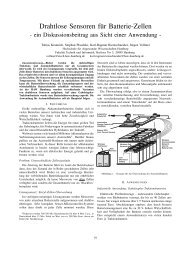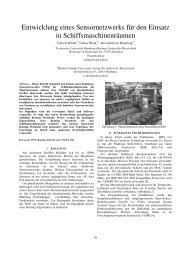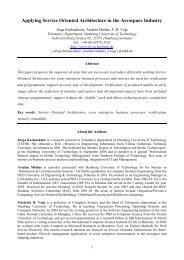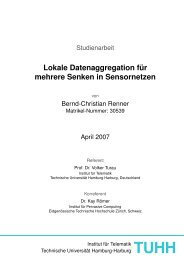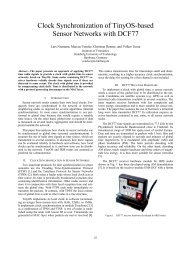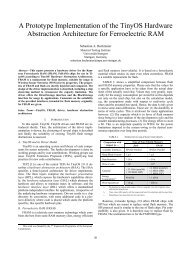Cross-Platform Protocol Development Based on OMNeT++
Cross-Platform Protocol Development Based on OMNeT++
Cross-Platform Protocol Development Based on OMNeT++
Create successful ePaper yourself
Turn your PDF publications into a flip-book with our unique Google optimized e-Paper software.
1 // Setup f o r <strong>OMNeT++</strong> in NED language<br />
2 // ( s k i p p e d d e c l a r a t i o n o f modules )<br />
3 network Network {<br />
4 submodules :<br />
5 s e n d e r : MySender ;<br />
6 r e c e i v e r : MyReceiver ;<br />
7 c<strong>on</strong>necti<strong>on</strong>s :<br />
8 s e n d e r . gateOut −−> r e c e i v e r . g a t e I n ;<br />
9 }<br />
10<br />
11 // Setup f o r AVR<br />
12 MySender s e n d e r ;<br />
13 MyReceiver r e c e i v e r ;<br />
14<br />
15 int main ( ) {<br />
16 s e n d e r . gateOut . c<strong>on</strong>nectTo ( r e c e i v e r . g a t e I n ) ;<br />
17 cometos : : i n i t i a l i z e ( ) ;<br />
18 cometos : : run ( ) ;<br />
19 return 0 ;<br />
20 }<br />
Listing 4: C<strong>on</strong>figurati<strong>on</strong> for <strong>OMNeT++</strong> and AVR<br />
While the former is d<strong>on</strong>e using the NED language and<br />
.ini files as ever (see lines 1-9), the latter requires a C++<br />
c<strong>on</strong>figurati<strong>on</strong> file c<strong>on</strong>taining the functi<strong>on</strong> main. This procedure<br />
is straightforward as depicted in the lines 12-20.<br />
3.5 Additi<strong>on</strong>al Target <str<strong>on</strong>g>Platform</str<strong>on</strong>g>s<br />
Currently, CometOS is implemented for the <strong>OMNeT++</strong><br />
simulati<strong>on</strong> envir<strong>on</strong>ment and the ATmega128RFA1 microc<strong>on</strong>troller<br />
with an integrated 802.15.4-compliant transceiver.<br />
Support for an platform based <strong>on</strong> an ARM Cortex M3 and<br />
a TI CC1120 transceiver is planned for near future.<br />
To ease transiti<strong>on</strong> to other hardware platforms, we strove<br />
for keeping the interface to the hardware-dependent part as<br />
slim as possible. The core framework at minimum needs the<br />
implementati<strong>on</strong> of a scheduler to realize message passing.<br />
As the CometOS core makes use of dynamic memory allocati<strong>on</strong>,<br />
this functi<strong>on</strong>ality must be available as well. Furthermore,<br />
the MAC abstracti<strong>on</strong> layer (see Sect. 3.2) has to be<br />
implemented to provide high-level access to the transceiver<br />
and enable transmissi<strong>on</strong>s to the wireless channel. Interfaces<br />
to peripherals, e.g., sensors, EEPROM, are currently not<br />
prescribed by CometOS and have to be added as needed.<br />
Note that CometOS doesn’t rely <strong>on</strong> C++’s RTTI, excepti<strong>on</strong><br />
handling, and the STL.<br />
4. EVALUATION<br />
In this secti<strong>on</strong> we evaluate CometOS in matters of resource<br />
demand, usability, and accuracy of the simulati<strong>on</strong>.<br />
For this purpose CometOS is implemented in <strong>OMNeT++</strong><br />
and for an AVR 8-bit microc<strong>on</strong>troller (using GNU’s C++<br />
compiler versi<strong>on</strong> 4.5). For the latter we use a microc<strong>on</strong>troller<br />
(ATmega128RFA1) with an embedded 802.15.4 compliant<br />
transceiver and 16 kB SRAM, 16 MHz clock frequency, and<br />
128 kB Flash memory.<br />
Most findings of this secti<strong>on</strong> originate from the experiences<br />
gained in the HelioMesh project [3]. In this project, we<br />
evaluate the feasibility of wireless mesh networks as c<strong>on</strong>trol<br />
technology for a field of self-powered heliostats. A testbed<br />
c<strong>on</strong>taining 93 wireless nodes was deployed in the heliostat<br />
field Jülich, Germany (see Fig. 2).<br />
Figure 2: HelioMesh Testbed Jülich, Germany<br />
(Latitude, L<strong>on</strong>gitude: 50.913316, 6.387691)<br />
4.1 Feasibility<br />
CometOS benefits from its close relati<strong>on</strong>ship with OM-<br />
NeT++, which allows a c<strong>on</strong>venient protocol development<br />
using the tools supported by simulator and Eclipse/CDT.<br />
Most software bugs in the HelioMesh communicati<strong>on</strong> stack,<br />
e.g., memory leaks, could be fixed with help of the simulator.<br />
When we deployed the code to the target platform, we<br />
<strong>on</strong>ly observed errors at driver level. Once the drivers were<br />
working as expected, no failures occurred that could not be<br />
detected and fixed within the simulati<strong>on</strong> envir<strong>on</strong>ment.<br />
The HelioMesh firmware instantiates 20 modules for different<br />
purposes. Those include routing, neighborhood, clustering,<br />
and applicati<strong>on</strong> protocols and build up a branched<br />
protocol stack. CometOS’s airframe c<strong>on</strong>cept and the object<br />
aggregati<strong>on</strong> have proven to be useful for creating complex<br />
protocol stacks. Both allow a loose coupling of modules,<br />
which highly increases the reusability of the developed protocols.<br />
Since the resource demand in <strong>OMNeT++</strong> is n<strong>on</strong>critical,<br />
we restrict the following analysis to the AVR implementati<strong>on</strong><br />
<strong>on</strong>ly. The core system and the tiny sample applicati<strong>on</strong><br />
(see Listings 1 and 4) needs 8.4 kB of flash memory<br />
and 478 Bytes statically allocated RAM. The firmware of<br />
the HelioMesh project (20 modules) occupies 62 kB and uses<br />
4.5 kB static and allocates in average 1.5 kB dynamic memory.<br />
Note that the memory c<strong>on</strong>sumpti<strong>on</strong> also depends <strong>on</strong> the<br />
number of instantiated modules and the used protocols and<br />
may significantly differ for various software. However, the<br />
used c<strong>on</strong>troller (ATmega128RFA1) easily meets the resource<br />
demand.<br />
4.2 Simulati<strong>on</strong> Accuracy<br />
We compared the accuracy of the simulati<strong>on</strong> with the<br />
testbed in Jülich. The latter is c<strong>on</strong>trolled via a basestati<strong>on</strong><br />
software, written in Java, which is c<strong>on</strong>nected via USB<br />
to a gateway node. In <strong>OMNeT++</strong>, the complete HelioMesh



